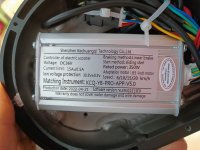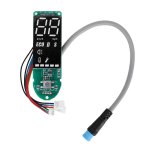ibra2672 said:
The new controller has also a self learn cable, could that solve the issue? I tried plugging but the only thing it did was make the wheel spin the other way.
If you've used the self-learn per the specific controller directions (most of them use it the same way), then the combo would be correct for the direction it's spinning in, assuming the self-learn works as it should.
If no-load current is low, and nothing is getting hot either no-load or under load, then the combo is probably correct.
Max no-load speed is generally proportional to battery voltage, assuming full throttle and no speed limiting in the controller. So if you had a 36v battery that only gave 30kmh (no load speed?) at full charge, and a 48v battery that gives 86kmh (no load speed?) at full charge, that's far from proportional (48v/36v= 1.34x higher, thus about that much faster...30kmh x 1.34 = 40kmh).
So either the new speed reading is wrong, the old speed reading is wrong, both are wrong, or something (timing advance, etc) is causing the motor to spin far faster than it should on the new controller, or something is limiting the speed on the old controller to much less than it should be able to go for the raw voltage supplied.
You also stated that the old display couldn't go past 30kmh; if the motor is actually spinning faster than that then to know what speed it is actually going you'd need some other speedometer. If you don't know it's actual speed you can't compare the old controller to the new one.
There are apps for phones that can use the camera as a tachometer, to give you the wheel rpm offground, then you can use online calculators for RPM to kph.
Also with the old controller the acceleration to max speed was much slower, like to 2 -3 sec to reach the max speed of 30kmh while with the new controller it doesn't even take 0.3-0.5 sec to reach 86kmh. I think the current draw with no load might be a lot different between the 2 controllers.
no-load (off-ground) current has just about nothing to do with the current under load (in use), or controller current limits--it's more about the specific motor itself and the way the controller is driving it (and whether there is non-neutral hall timing, if it is a sensored controller and motor).
So it should still be just about the same no-load current for both controllers, for the same motor, etc.
The faster acceleration new vs old can be because of a higher current limit on the new controller, and/or the higher voltage, either or both of which would provide more total power to the motor.



